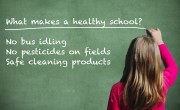
A simple three-point checklist for parents of school-age children to help them determine if their child's school environment is as healthy as it can be.
Port Washington, New York, September 3, 2015 (Newswire.com) - Grassroots Environmental Education, a science-based environmental health non-profit organization based in New York, has issued a simple three-point checklist for parents of school-age children to help them determine if their child’s school environment is as healthy as it can be.
• Does the school prohibit the idling of school buses and other vehicles on school property?
"By taking steps to reduce chemical exposures in schools through initiatives such as the ChildSafe School, we can make a wise investment in the future of our children."
Dr. Leo Trasande, Associate Professor at New York University's School of Medicine.
• Does the school prohibit the use of chemical pesticides on school playing fields and green spaces?
• Does the school use only bio-based cleaning products that meet strict criteria specifically established to protect children’s health?
“A school is a child’s second home, so it’s important that their school environment is as safe as it can be,” says Grassroots Environmental Education Executive Director Patricia Wood. “Chronic, low level exposures to toxins commonly found in and around schools can exacerbate allergies and asthma, cause neurological symptoms, and has the potential to cause serious long-term health problems for children.”
According to researchers, rates of asthma, cancer,, certain birth defects, learning disabilities and obesity are all on the rise among America’s school children. Moreover, a growing body of evidence links these increases to exposure to environmental chemicals, including diesel exhaust, pesticides and chemicals commonly found in petroleum-based institutional cleaning products.
In response, Grassroots has created an awareness and advocacy program focused on these three exposures. The ChildSafe School Program (www.thechildsafeschool.org) provides a policy-based framework for addressing these issues, and includes films, Q&A sheets, sample policies and checklists to help parents and other advocates bring about change in their local schools.
“We’ll never have 100% certainty that a particular exposure has caused an injury or illness, but we have a responsibility to our children to prevent an unnatural experiment from occurring,” says Dr. Leo Trasande, pediatrician and Associate Professor at New York University’s School of Medicine. “By taking steps to reduce chemical exposures in schools through initiatives such as the ChildSafe School, we can make a wise investment in the future of our children.”
More information, including all advocacy materials, is available at the program website.
References:
1. Asthma incidence and mortality have more than doubled [Centers for Disease Control and Prevention (CDC) 1995a, 1995b].
2. Despite declining mortality, incidence of acute lymphocytic leukemia increased by 61.7% from 1973 to 1999 (Robison et al. 1995). Incidence of primary brain cancer increased by 39.6% from 1973 to 1994 (Schechter, 1999)
3. Birth defects of the male reproductive system, such as hypospadias, doubled in frequency from 1970 to 1993 (Paulozzi et al. 1997).
4. Neurodevelopmental disorders—including learning disabilities, dyslexia, mental retardation, attention deficit disorder, and autism—are highly prevalent and affect 5–10% of the 4 million babies born in the United States each year (Bertrand et al. 2001; CDC 2004a, 2004b; LeFever et al. 1999; Safer et al. 1996; Zito et al. 2000).
5. Prevalence of childhood obesity has trebled (Galvez et al, 2003)
About Grassroots Environmental Education
Grassroots Environmental Education is an environmental health non-profit communications organization that bridges the gap between emerging science and public awareness.
Contact Information
Doug Wood
Associate Director
(516) 883-0887
daw@grassrootsinfo.org
http://www.grassrootsinfo.org
Share: